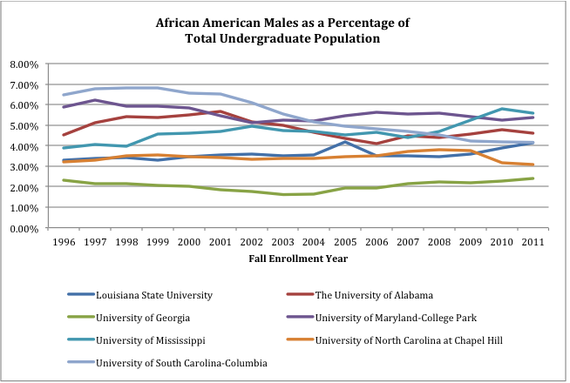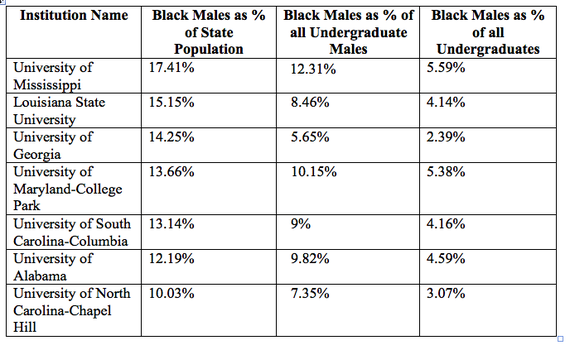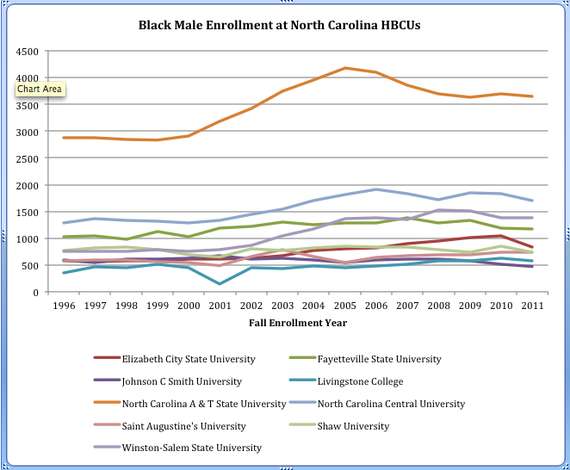Co-authored by Heather Collins, a master's student in the higher education program at the University of Pennsylvania.
Julia Craven of the Daily Tarheel published an article on October 14 noting that only 98 black undergraduate men were enrolled in the class of 2017 at the University of North Carolina at Chapel Hill. These 98 men represent 2.5 percent of the 3,946 first-year freshmen, significantly less than the percentage of college-aged black men in the state of North Carolina. Application statistics indicate that admitted African American men reflect the average admittance rate for UNC; however, African Americans men are applying to UNC at lower rates than other groups. There is also a slight discrepancy in how race is calculated between the admissions and institutional research (IR) and assessment departments. IR only counts those men that self identify as African American only whereas admissions includes those that identify as two or more races when one of those races identified is African American.
Two reasons were given as possibly influencing the lower enrollment of black men. Taffye Clayton, vice provost for diversity and multicultural Affairs, indicated that self-reporting presents challenges in capturing reliable data that are comparable to previous years. Clayton mentions lower numbers could be due to changes in the US Census that now allow students to indicate more than one race, which is counted differently across campus. In addition, Ashley Memory, assistant director of undergraduate admissions, indicated there are also more students not identifying race at all on applications, possibly skewing numbers. However, national research shows that most individuals who do not check a racial category are white students. Interestingly, campus officials did not reflect on admissions or retention practices or campus climate in their assessment of the lower numbers of black men.
Debate continues about the success of outreach programs, with some people stipulating that the athletic department is the most successful recruiter of African American men and asking what message this communicates to the UNC community. Despite interviewed students claiming there is a tolerant culture for African American men on campus at UNC, outreach efforts have struggled to improve enrollment rates. IPEDS data reveal African American men have consistently made up less than four percent of the undergraduate population.
Student groups have come together to voice concern over the lack of representation at UNC. Other students at other public institutions have acknowledged a similar statistic, most notably at UCLA where Sy Stokes, a UCLA student, posted a video commenting on low enrollment of African Americans.
When analyzing flagship institutions in seven states with the largest percentage of African Americans, UNC is not alone. In 2011, black male enrollments at Louisiana State University, University of Alabama, University of Georgia, University of Maryland-College Park, University of Mississippi, and University of South Carolina represented a significantly lower percentage than Black males in the population in their respective states. The chart below shows the relationship between African American males as a percentage of the state population and enrollment at these institutions.
And, the graph below suggests a consistent trend over time of underrepresentation, with University of Georgia as a regular outlier. Consider black male undergraduate enrollment between 1996 and 2011 in the seven states with the largest black male populations.

Returning to the state of North Carolina, black male enrollment at North Carolina's HBCUs has been stable from 1996 to 2002, with a steady increase until roughly 2006-2007, when enrollment began to level off. In particular, North Carolina A&T University and North Carolina Central University are doing the heavy lifting in terms of enrolling of black men. And of note, St. Augustine's College, a private liberal arts school, has consistently had more male students than female students, defying trends on most college campuses when it comes to gender.
Given the increased attention to African American males, the many programs focused on preparing, recruiting and retaining black men, and our desire to provide equal opportunity to all citizens in the state of North Carolina and across the nation, it would seem that North Carolina's HBCUs should be applauded at the state level for their ability to enroll African American men and for doing the lion's share of the work of educating black men. Perhaps those flagship universities in states with the largest numbers of black men should look to their HBCU counterparts for advice on how to recruit, retain, and graduate African American men.
In order to serve black men in the most effective, efficient, and just ways, we need all colleges and universities to examine their practices that keep black men out and that work against black student male success. We need as many doors open as possible to black men at both HBCUs and majority institutions and we need the people behind those doors to provide a welcoming environment.


